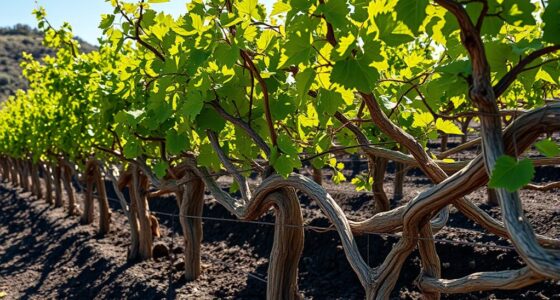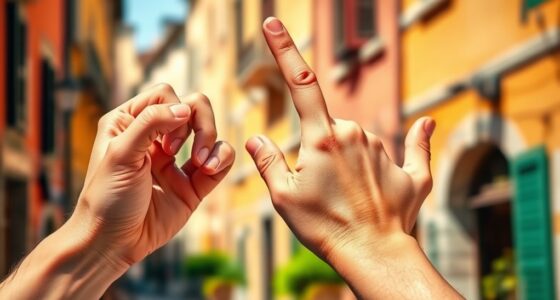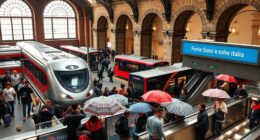During the Renaissance, families like the Medici used art patronage as a way to display their power, wealth, and religious devotion. By funding masterpieces from artists such as Michelangelo and Leonardo da Vinci, they helped shape Florence’s cultural landscape. Their strategic investments fostered artistic innovation and promoted humanist ideas, transforming art into a tool for political and religious influence. To understand how their support left a lasting legacy, keep exploring how patrons influenced Renaissance culture.
Key Takeaways
- Wealthy families like the Medici used art patronage to demonstrate power, influence, and religious devotion during the Renaissance.
- The Medici commissioned masterpieces from renowned artists, elevating Florence as a center of artistic innovation.
- Patronage networks fostered collaboration among artists, scholars, and theologians, promoting cultural growth.
- Support for new artistic techniques and humanist ideas transformed art into political and religious expression.
- The Medici’s strategic funding established Florence’s reputation as a hub of Renaissance cultural achievement.

During the Renaissance, art patronage became a powerful way for wealthy individuals and institutions to display their influence and devotion. As you explore this era, you’ll see how families like the Medici used their wealth not just to commission stunning works but to cement their status and shape cultural trends. The Medici influence extended far beyond Florence, as their patronage networks spread throughout Italy, connecting artists, scholars, and other patrons. These networks created a web of support that fueled artistic innovation and helped establish Florence as a hub of Renaissance culture.
The Medici’s extensive patronage networks fueled Renaissance innovation across Italy.
When you consider patronage during this period, it’s clear that the Medici family played a central role. They invested heavily in art, commissioning masterpieces from giants like Michelangelo, Botticelli, and Leonardo da Vinci. Their patronage wasn’t just about decorating palaces; it was a strategic move to showcase their power and piety. By funding religious and secular projects, the Medici positioned themselves as the cultural and political leaders of Florence. Their influence was so profound that many artists depended on their patronage for survival, shaping the style and themes of Renaissance art to align with Medici ideals.
The patronage networks established by the Medici were expansive. They cultivated relationships with artists, theologians, and intellectuals, creating a collaborative environment where ideas flourished. These networks allowed for the exchange of knowledge and artistic techniques, pushing the boundaries of traditional art. As you observe Renaissance artworks, you’ll notice how motifs, techniques, and themes often reflect the Medici’s interests and values. Their strategic patronage helped elevate art from mere decoration to a powerful tool for political and religious expression.
By supporting innovative artists, the Medici also fostered a renaissance of ideas. Their patronage extended to humanism, encouraging the revival of classical learning and the integration of science and philosophy into art. This cultural environment attracted talented individuals from across Italy and beyond, further strengthening their patronage networks. As a result, Florence became a thriving center where art, politics, and intellectual pursuits intertwined, all under the influence of the Medici family. Additionally, the Medici’s strategic use of art as a form of political power reinforced their dominance and legacy within Florence and beyond.
In essence, your understanding of Renaissance art isn’t complete without recognizing the Medici’s influence and their patronage networks. They didn’t just fund art—they shaped the very fabric of the cultural landscape. Through strategic patronage, they turned Florence into a beacon of artistic achievement, leaving a legacy that still influences how we view Renaissance art today.
Frequently Asked Questions
How Did Medici Family Influence Political Power Through Art?
You see, the Medici influence extended into politics through their strategic use of political art. By commissioning grand murals and sculptures, they displayed their power and wealth, subtly reinforcing their authority to viewers. This art served as visual propaganda, shaping public perception and demonstrating their political dominance. Through these masterpieces, the Medici family solidified their control, making political art a key tool in strengthening their influence and legacy in Florence.
What Were the Economic Impacts of Renaissance Patronage?
You see the economic impacts of renaissance patronage in the thriving art market and booming art investment. As patrons like the Medici funded artists, demand for artworks surged, boosting local economies and creating jobs. This cycle of investment, production, and trade increased wealth for cities, stimulated commerce, and encouraged innovation. By supporting art, you help foster economic growth, cultural exchange, and the expansion of creative industries during this vibrant period.
How Did Art Patronage Differ Among Italian City-States?
You’ll notice that art patronage varied among Italian city-states through urban commissions and religious sponsorships. For example, Florence’s wealthy families funded public artworks and religious projects to showcase civic pride and faith. Venice’s patrons focused on grand architecture and religious art to demonstrate political power. These differences reflect each city’s unique priorities, shaping regional artistic styles and cultural identity through diverse patronage practices.
Did Women in Noble Families Contribute to Art Patronage?
Imagine a regal woman, her hand gracefully guiding a brush or commissioning a grand portrait. Women patrons in noble families definitely contributed to art patronage, wielding noble influence behind the scenes. They supported artists, sponsored projects, and shaped cultural trends, often through strategic alliances and private collections. Their involvement added depth and sophistication to the artistic landscape, proving that noble women played a essential role in fostering Renaissance creativity and innovation.
How Did Patronage Affect the Careers of Renaissance Artists?
Patronage profoundly impacted your career as a Renaissance artist by providing steady commissions through the commissioning processes and fostering close relationships with powerful families like the Medici. These connections often led to exclusive opportunities, higher status, and financial stability. As a result, your reputation grew, enabling you to develop innovative styles and influence the artistic landscape, all thanks to the support and networks established by your patrons.
Conclusion
You might find it astonishing that the Medici family alone funded over 80 major artworks during the Renaissance, shaping an era of extraordinary cultural achievement. Their patronage didn’t just support artists; it transformed society and left a lasting legacy. By investing in art, they created a lasting impression on history, proving that your support can truly inspire greatness. Remember, your influence today could shape tomorrow’s cultural masterpieces just like the Medici did centuries ago.









